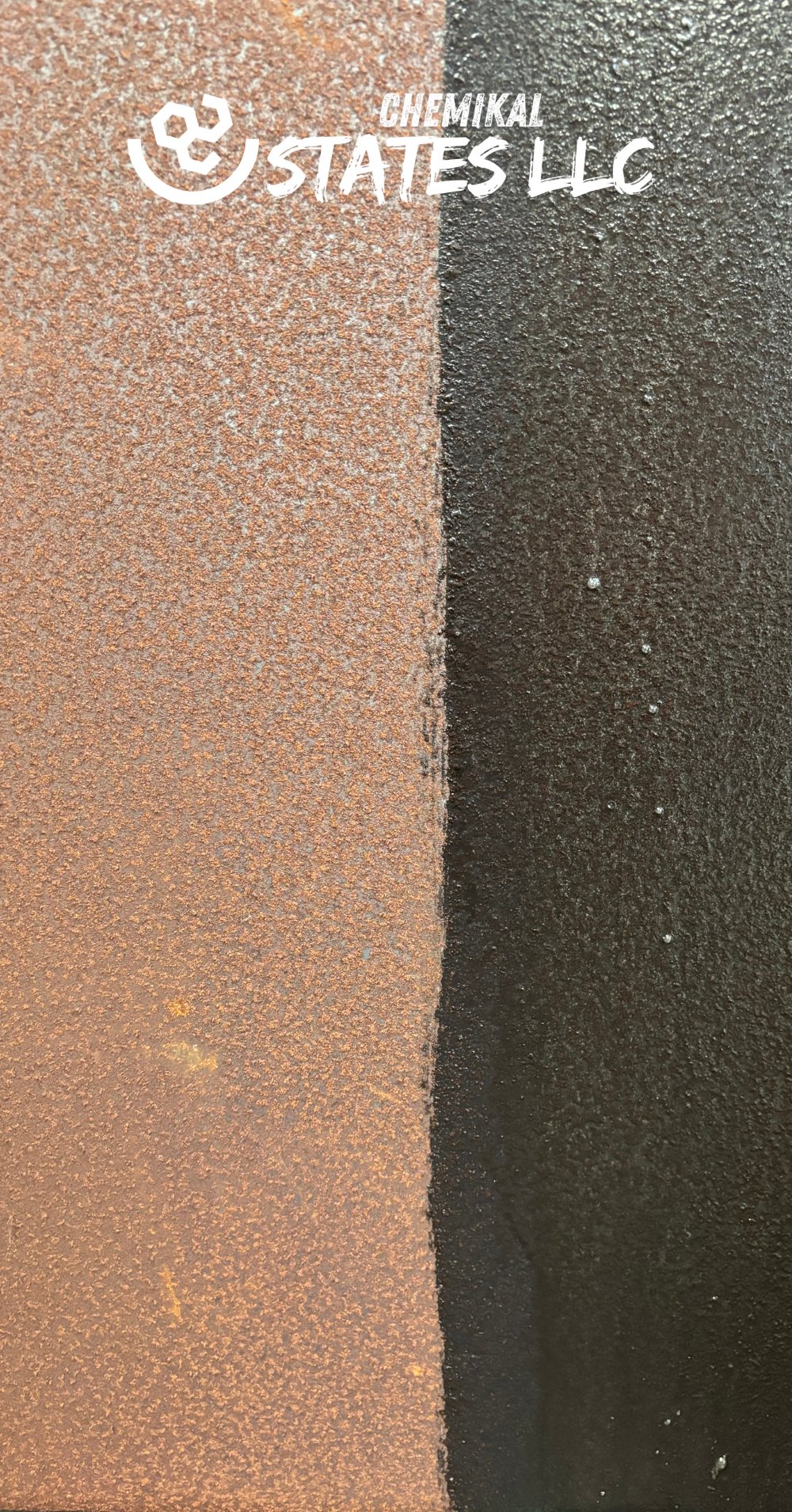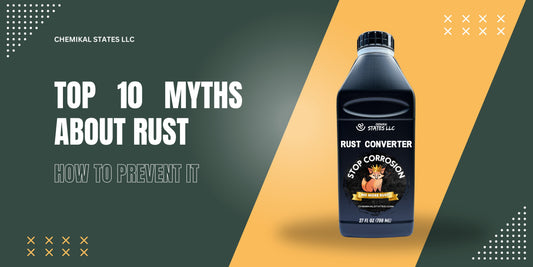
Top 10 Myths About Rust and How to Prevent It
Share
Rust is a common problem that affects a wide range of metal surfaces, from vehicles to outdoor furniture and even household tools. Despite its prevalence, there are many myths and misconceptions about rust that can lead to ineffective prevention and treatment strategies. In this article, we’ll debunk the top 10 myths about rust and provide you with the facts you need to protect your metal surfaces effectively. Plus, we'll show you how to use Rust Converter to stop rust in its tracks and prevent future corrosion.
Myth 1: Rust Only Occurs in Wet or Humid Conditions
Fact: While it’s true that rust is more likely to form in wet or humid environments, it can also develop in dry conditions. Rust forms when iron or steel is exposed to oxygen and moisture, but even the small amount of moisture present in the air (humidity) can trigger the rusting process. That’s why you may notice rust on metal objects that are kept indoors but are still exposed to air. Rust prevention should always be a priority, regardless of the climate.
Preventing Rust:
To prevent rust in any environment, consider using a Rust Converter. By converting rust into a stable compound and sealing the surface, it provides protection against further corrosion. Visit our Rust Converter shop to learn more about our top-rated product.
Myth 2: Stainless Steel Doesn’t Rust
Fact: Stainless steel is more resistant to rust than regular steel, but it is not completely immune. Stainless steel contains chromium, which forms a protective layer of chromium oxide on the surface. However, this layer can be damaged by scratches, exposure to harsh chemicals, or environmental factors, allowing rust to form. In harsh conditions, like those found in coastal areas, even stainless steel can rust over time.
Preventing Rust on Stainless Steel:
Regular maintenance and the use of protective coatings can help prevent rust on stainless steel. If rust does appear, a Rust Converter can help treat the affected areas and prevent further corrosion.
Myth 3: Painting Over Rust Stops It from Spreading
Fact: Painting over rust without treating it first is a temporary fix at best. The rust will continue to spread beneath the paint, eventually causing the paint to bubble and peel. To stop rust from spreading, you need to treat it with a Rust Converter before applying paint.
Preventing Rust Spread:
By using a Rust Converter before painting, you neutralize the rust and create a stable, paintable surface. This ensures that the rust won’t continue to spread under the paint. For more information on how to apply Rust Converter correctly, check out our step-by-step guide.
Myth 4: Rust Is Just a Cosmetic Issue
Fact: Rust is much more than a cosmetic issue—it can weaken the structural integrity of metal objects, leading to dangerous situations. For example, rust can cause metal beams or car frames to become brittle and prone to failure. Ignoring rust can result in costly repairs or even accidents.
Preventing Structural Damage:
Prevent rust from compromising the strength of your metal structures by treating it early with a Rust Converter. This will stop the rust from spreading and help maintain the integrity of the metal. Learn more about the importance of rust prevention here.
Myth 5: All Metals Rust
Fact: Not all metals rust. Rust is a specific form of corrosion that occurs only in iron and its alloys, such as steel. Other metals, like aluminum and copper, undergo different forms of corrosion. For example, aluminum forms a protective oxide layer when it corrodes, which actually helps protect the metal underneath.
Understanding Metal Corrosion:
Knowing the type of metal you’re dealing with is crucial for selecting the right rust prevention or corrosion treatment method. While Rust Converters are effective on iron and steel, other metals may require different treatments. Explore our comprehensive rust prevention solutions here.
Myth 6: Rust Removers and Rust Converters Are the Same
Fact: Rust removers and Rust Converters are not the same. Rust removers strip away rust from the surface, leaving bare metal that needs immediate protection to prevent re-rusting. Rust Converters, on the other hand, chemically convert rust into a stable compound and provide a protective coating that can be painted over.
Choosing the Right Product:
For long-lasting protection, especially on heavily rusted surfaces, a Rust Converter is often the better choice. It not only treats the rust but also prepares the surface for further protection. Compare the benefits of each in our detailed article here.
Myth 7: Rust Can Be Completely Removed by Scrubbing
Fact: Scrubbing can remove surface rust, but it won’t eliminate rust that has penetrated deeper into the metal. To completely stop rust, you need to use a Rust Converter, which penetrates the rust and chemically converts it into a stable compound. Simply scrubbing the surface will not stop the rust from continuing to corrode the metal underneath.
Effective Rust Treatment:
Using a Rust Converter after scrubbing ensures that all rust, including what’s beneath the surface, is treated. This prevents the rust from returning and extends the life of your metal surfaces. Learn how to apply Rust Converter effectively here.
Myth 8: Once Rust Is Treated, It’s Gone Forever
Fact: While treating rust with a Rust Converter stops the rusting process, it doesn’t mean that rust will never return. Metal surfaces are still vulnerable to new rust formation if they are exposed to moisture and oxygen. That’s why it’s important to apply a protective coating after using a Rust Converter.
Long-Term Rust Prevention:
To ensure long-term protection, always apply a topcoat after treating rust with a Rust Converter. This seals the surface and provides a barrier against the elements. Discover more rust prevention tips in our Ultimate Guide to Rust Converter.
Myth 9: Rust Can’t Be Prevented in Coastal Areas
Fact: While coastal areas present a challenging environment for metal surfaces due to high salt content and humidity, rust can still be prevented with the right measures. Regular maintenance, protective coatings, and the use of Rust Converters can significantly reduce the risk of rust in these environments.
Coastal Rust Protection:
For those living near the coast, it’s crucial to use a Rust Converter as part of a regular maintenance routine to protect metal surfaces from rust. Find out more about protecting metal in coastal environments here.
Myth 10: Rust Converters Are Only for Industrial Use
Fact: While Rust Converters are indeed popular in industrial settings due to their effectiveness, they are also ideal for DIY projects at home. Whether you’re restoring a car, protecting outdoor furniture, or maintaining tools, a Rust Converter is an accessible and effective solution for anyone looking to prevent rust.
Versatile Applications:
Rust Converters can be used in a variety of settings, from large-scale industrial applications to small DIY projects. For more ideas on how to use Rust Converters in your home projects, check out our Rust Converter for Sale.
Conclusion: Separate Fact from Fiction
Understanding the truth about rust and how to prevent it is essential for protecting your metal surfaces and extending their lifespan. By debunking these common myths and providing you with the facts, we hope to empower you to take the right steps in rust prevention. Whether you’re dealing with minor rust spots or major corrosion, a Rust Converter is your best defense against the damaging effects of rust.
For more information on our top-rated Rust Converter and how it can help you protect your metal surfaces, visit our shop today. Don't let rust take over—take control with the right tools and knowledge.
FAQ: Common Questions About Rust Converters
1. Can I Paint Over Rust Converter?
Q: Is it possible to paint over a Rust Converter treatment?
A: Yes, after the Rust Converter has fully cured, you can apply a primer and topcoat. This not only enhances the appearance but also provides additional protection against rust.
For more on painting over Rust Converters, read our How to Use Rust Converter: A Step-by-Step Guide for Beginners.
2. How Long Does Rust Converter Last?
Q: How durable is the protection provided by a Rust Converter?
A: When applied correctly, the protection provided by a Rust Converter can last for several years, especially if followed by a protective topcoat. Regular maintenance is key to ensuring long-term protection.
Learn more about the durability of Rust Converters here.
3. Can Rust Converter Be Used on Aluminum?
Q: Is Rust Converter effective on aluminum surfaces?
A: No, Rust Converters are designed for iron and steel surfaces. For aluminum, different corrosion treatments are required.
For more on using Rust Converters on different metals, see our Rust Remover vs. Rust Converter: What's the Difference?.
4. Is Rust Converter Safe to Use?
Q: What safety precautions should I take when using a Rust Converter?
A: Rust Converters are generally safe to use when following the manufacturer's instructions. Always wear protective gloves and work in a well-ventilated area.
For more safety tips, visit our Ultimate Guide to Rust Converter.
5. Where Can I Buy Rust Converter?
Q: Where is the best place to purchase a high-quality Rust Converter?
A: You can buy our top-rated Rust Converter directly from our online store or through Amazon for quick and convenient delivery.
Learn more about our products and purchasing options here.










